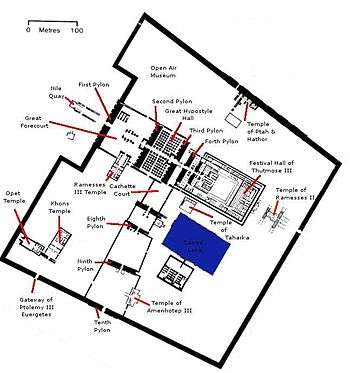Great Karnak Inscription
The Great Karnak Inscription is an ancient Egyptian hieroglyphic inscription belonging to the 19th Dynasty Pharaoh Merneptah. A long epigraph, it was discovered at Karnak in 1828–1829. According to Wilhelm Max Müller, it is "one of the famous standard texts of Egyptology... [and has been] ... one of the greatest desiderata of scholars for many years."[1]
_-_plate_52_from_Mariette_Bey.jpg)

The Great Karnak Inscription is located on the west (inside) of the east wall of the Cachette Court, in the Precinct of Amun-Re of the Karnak temple complex, in modern Luxor. It runs from the fourth pylon of the great sanctuary to the eighth pylon.[2]
It was first identified by Champollion, and later partly published by Karl Richard Lepsius.[3]
It includes a record of the campaigns of this king against the Sea Peoples.[4][5]
The 79-line inscription (which has now lost about a third of its content) shows the king's campaigns and eventual return with booty and prisoners.[6][5]
It is the longest surviving continuous monumental text from Egypt.[5]
It has been designated KIU 4246 by the Centre Franco-Égyptien d'Étude des Temples de Karnak.[7]
Bibliography
- Muller, Egyptological Researches
References
- Muller, p.25
- Muller, p.25
- Denkmäler aus Aegypten und Aethiopien, volume iii, 199a
- Weigall, Arthur (1910). A Guide to the Antiquities of Upper Egypt. London: Mentheun & Co. p. 109. ISBN 1-4253-3806-2.
- Colleen Manassa, : "The seventy-nine line inscription is located on the interior of the east wall of the "Cours De la Cachette," directly north of a copy of the Hittite treaty from the reign of Ramesses II and in conjunction with other reliefs of Merneptah (PM II, p. 131 [486])... Unfortunately, the excavation of the Cours De la Cachette between 1978-1981 by the French expedition at Karnak did not discover any new blocks belonging to the Great Karnak Inscription of Merneptah, although it did demonstrate that the court was filled with many ritual and religious scenes in addition to its known military themes (F. LeSaout, "Reconstitution des murs de la Cours De la Cachette," Cahiers De Karrah VII (1978-1981) [Paris, 1982], p. 214)."
- Blyth, Elizabeth (2006). Karnak: Evolution of a Temple. Oxford: Routledge. pp. 164–165. ISBN 0-415-40487-8.
- http://www.cfeetk.cnrs.fr/karnak/?iu=4246
